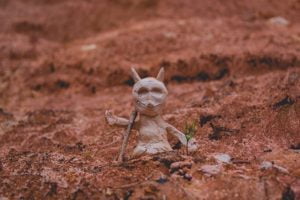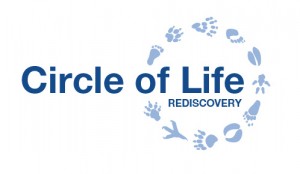Mental Meandering and the Outdoors
By Kate Macairt (Director CLR)
Children of all ages need to go outdoors to support their mental health and wellbeing. Children need the enriched sensory inputs which outdoors can provide. This does not have to be a beautiful wild landscape or forest, there are wild spaces in every city worth discovering.
In her TED talk (30/9/16) Emma Marris stresses there is no division between humans and Nature. We are part of nature, we are part of the living system of this planet. She encourages us to take a short walk through the urban jungle and find how, no matter how much concrete we pour, time will open cracks and shoot new life. For a disenfranchised young person, the bravery of the little weed forcing its way through such obstacle provides a metaphor which system 1 thinking notices. (See my previous Blog on System 1 and 2).
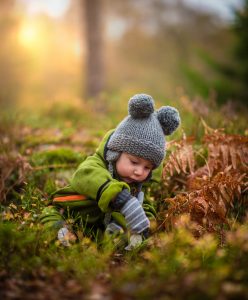 Conquering Nature has been a significant driving force in the evolution of humans. The modern human brain still contains elements of our ancestor Neanderthal brain. What was absolute survival behaviour for early humans is still the brain’s default mode and when we are stressed by events in our life we will still adopt the same response as our ancestors: fight freeze flight.
Conquering Nature has been a significant driving force in the evolution of humans. The modern human brain still contains elements of our ancestor Neanderthal brain. What was absolute survival behaviour for early humans is still the brain’s default mode and when we are stressed by events in our life we will still adopt the same response as our ancestors: fight freeze flight.
The development of the human for rational logical thinking has set us apart, humans have always explored and questioned their place within the natural scheme of things and in more recent times struggled for domination over other animals, plants, rivers, rocks oceans. The success of the domination has been over whelming and in Earth time super- fast. As a species we have fast tracked the development of our cognitive thinking skills. We are amazing and can create anything we imagine, almost. But it is very clear that now we pay the price for thinking we are above or exempt from the natural system. It is our young humans who will face the clean up after hundreds of years of irresponsible partying by so called grown- ups.
Perhaps it would be easier now to carry on trashing and abusing the hand which feeds us. Perhaps we do need more gadgets and systems which will help distance us from our nature. Implant chips so we can be read like a robot. Surrender our ability to find our way, turn on our lights, remember appointments and so on. We should be treading with more caution. History clearly shows that it is not possible to change natural phenomena without there being a knock-on effect and these knock-on effects often create a less safe world for humans.
I am a child of the 1960’s and have grown up with awareness that this is no new argument but what has changed significantly I feel is the effect of the modern human world on children. In 1989 Morris Berneman wrote ‘Coming to Our Senses’. An acknowledgement of how the evolutionary process has divorced us from our embodied experience of the world. He warns of the de-humanising effect of believing we are above or outside the natural world and the existential void that disembodiment creates.
Remember the two infants, our indoor and outdoor babies? (Again, see my previous Blog). Let’s assume baby 1 continues to have predominantly indoor experiences, what sensory memories is she forming? Modern urban city life encourages us to stay indoors. From birth until she is three years old Infant 1 has been kept safe inside the aircon apartment, she gets to play with playdough while in her high chair and she likes bubbles in her bath. She has an Ipad on which she watches age appropriate cartoons, she loves Peppa Pig (consider how many products aimed at young children utilise animals with human characteristics, flowers and trees that can talk, and rural locations). There is a beautiful jungle mural on the nursery wall. Baby 1 has been kept safe from germs and is carried from building to car to building in safety seats. All the time her little brain is growing. A baby’s brain grows 64% in the first year of life. Baby 1 is making the foundation ‘compost’ which will unconsciously impact on her future behaviour as she matures and faces new experiences.
 Baby 2 has also been inputting sensory data. Her arms have been stretching trying to reach the grass as her arm flops over she rolls and now she is lying on her tummy. She grabs at the green spikes which are waggling in front of her she pulls at the strands a chubby fistful of grass… and now to taste! As Baby 2 gets bigger she enjoys mixing mud pies, she will lift the stone and look for the woodlice that live there and she has found her own special place under a bush where some of her toys live. Both babies are safe and have working models of secure attachment. Both babies are having their basic needs met and both will grow up and no doubt do ok at school. (If you wish to train to work in the outdoors, see our Forest School Training courses).
Baby 2 has also been inputting sensory data. Her arms have been stretching trying to reach the grass as her arm flops over she rolls and now she is lying on her tummy. She grabs at the green spikes which are waggling in front of her she pulls at the strands a chubby fistful of grass… and now to taste! As Baby 2 gets bigger she enjoys mixing mud pies, she will lift the stone and look for the woodlice that live there and she has found her own special place under a bush where some of her toys live. Both babies are safe and have working models of secure attachment. Both babies are having their basic needs met and both will grow up and no doubt do ok at school. (If you wish to train to work in the outdoors, see our Forest School Training courses).
What Baby 1 lacks is the opportunity to explore her world in its true entirety. The outdoors and all that it offers is an important part of our story, our personal story and our ancestral narrative. If we are to feel confident in our capacity to be resilient then we need to develop a positive relationship with our world.
A little boy of 3 years is on the beach, I am observing him and his mother from a distance. It is a beautiful sunny day he is following his mum, they are walking up from the sea shore across rocks. He scrambles over the boulders like a bear cub, all fours finding his balance, his little bare feet scrunch as he walks, a little gingerly at first, over the pebbles but in no time he is striding ahead. He is completely Master of his body moves and his quiet humming communicates his sense of satisfaction with life. Some time passes, the same little boy is again returning from the sea following his mother. This time he slips and falls and for a moment he disappears behind a boulder, then there is a wail! Mum is quick to respond, has scooped him up and is hugging him. She picks him up, dusts him off and he is ready to start all over again. Mum walks on and the boy continues his scrambling and balancing.
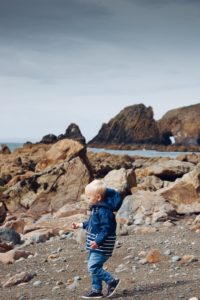 So much sensory information has automatically been experienced and the boys developing Superintendent will have noted ‘I fell over, it hurt, but not for long’. He has felt confirmation that the world provides fun and satisfaction and he is completely justified in receiving it. When it goes wrong it hurts but mum’s hug has reassured him to continue. I know, not rocket science is it? But what you may not have considered before is how important it is for that activity to have been outdoors. The power of the event would not have been the same had the boy been in the JungleTumble play world climbing foam blocks and plastic balls.
So much sensory information has automatically been experienced and the boys developing Superintendent will have noted ‘I fell over, it hurt, but not for long’. He has felt confirmation that the world provides fun and satisfaction and he is completely justified in receiving it. When it goes wrong it hurts but mum’s hug has reassured him to continue. I know, not rocket science is it? But what you may not have considered before is how important it is for that activity to have been outdoors. The power of the event would not have been the same had the boy been in the JungleTumble play world climbing foam blocks and plastic balls.
The dislocation of mind and body may be an effect of Western culture’s preoccupation with individualism and materialism. Eastern cultures have traditionally maintained more awareness of the harmony of mind and body, this can clearly been seen in the difference between Western and Eastern medicine. As the global modern technological world continues to expand our understanding of what reality is in being tested. For several years I have visited and worked in South East Asian countries training child counsellors and psychotherapists to become Play Therapists. The same mental health issues are manifesting in the young of China, Indonesia, Singapore as in London, USA, France. It is our young who have to deal with the ‘knock-on’ effect of the new technology. The seductive allure of computer worlds have been masterfully attuned to our addictive natures.
I loose count of how many young people I have worked with and who supervisees are working with, for whom playing on-line games has replaced most other social events. It is very usual now for young people to spend more time online engaging with each other as an avatar than taking ‘the risk’ of actually going out and engaging with a more unpredictable reality. The problems with this retreat into an internal world of virtual reality is the limited sensory input, the lack of somatic experience to such an extent that the Self is negated and projected onto a computer generated character who becomes ‘Me’. Circle of Life Rediscovery are running a new course in the Autumn – Mental Health, Resiliency Training in Nature. Please register your interest here.
A child who lacks resilience will be drawn to the computer game and virtual worlds like a moth to the flame. The bedroom becomes the sanctuary the outside world dangerous. I guess it doesn’t take too much imagination to see how that young person who lacks resilience and fears the outdoors world and what is in it, who is addicted to playing violent games in which success equates to body count, how the boundaries between realities may begin to merge until one day you can step out of the bedroom as your avatar and use a real gun or knife and kill real people.
The intense sense of loneliness and isolation from the physical world and others is at the root of most mental ill health. It does not require amazing gardens or wild plains to find our connection. If you happen to be reading this and are in a busy street with traffic, or on a park bench look down at the ground. Envisage a 10cm square drawn onto the ground. Now look closer at what is inside your square, a magnifying glass is very useful. This is an enjoyable game to play with all ages and if you were to have a 10cm square piece of paper and colouring pens you could try and capture on paper what you see. For the young child this sort of focus activity is very beneficial for connecting System 1 and System 2. The important thing is to be allowed to draw what you want to draw: do your own looking, seeing, interpreting.
Another effective simple outdoor focus game is to prepare a collection of objects, for example petals, leaves, sticks, stones, sweet wrappers. Create one big pile of confusion with them all jumbled together. The game is to see how quickly the chaotic mess can be sorted into piles of same or similar. Again, there is no right or wrong way here. Sorting things how you perceive they should be sorted is satisfying and simple. It is a child-led (or person-led) activity and is educational because of the intensity of the sensory inputs: the freedom within the activity to make choices ( or to negotiate if in teams) gentle connection between sensory System 1 and pattern seeking System 2.
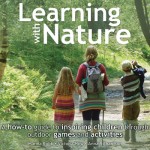 I recommend Marina Robb’s book ‘Learning with Nature’ for more ideas on outdoor games and activities. Whether in a Park, fields, or a scrubby patch in the back yard I encourage you and your children to get out more. Smell, look, taste, listen, touch find out what is safe and what isn’t. Have fun, breathe more deeply stretch your arms in the air, feel your feet grounded on earth. It is never too late to add more enrichment to your sensory network; the ‘compost’ of your foundation brain.
I recommend Marina Robb’s book ‘Learning with Nature’ for more ideas on outdoor games and activities. Whether in a Park, fields, or a scrubby patch in the back yard I encourage you and your children to get out more. Smell, look, taste, listen, touch find out what is safe and what isn’t. Have fun, breathe more deeply stretch your arms in the air, feel your feet grounded on earth. It is never too late to add more enrichment to your sensory network; the ‘compost’ of your foundation brain.
“The whole of science and one is tempted to think the whole of the life of any thinking man, is trying to come to terms with the relationship between yourself and the natural world. Why are you here and how do you fit in and what’s it all about?”
Sir David Attenborough
Landplay Therapy – Two Day Training Course with Kate Macairt.
Kate will be running her two day Landplay training in Essex on 25th & 26th May 2019. Please visit the Circle of Life Rediscovery website for further information and view full course information here.
Transforming education, health and family through nature.
Circle of Life Rediscovery provides exciting and highly beneficial nature-centred learning and therapeutic experiences for young people, adults, and families in Sussex woodlands, along with innovative continuing professional development for the health, well being and teaching professionals who are supporting them.
Sign up to our newsletter for updates about our courses, CPD’s, well-being & nature based training and events.
Recommended related reads
Berne Morris: 1989; Coming to our Senses
Brazier C: 2018; Ecotherapy in Practice
Jennings Sue: 2001; Embodiment-Projection-Roleplay
Kahneman D ;2011; Thinking Fast and Slow
Knight S: 2013; Forest School and Outdoor Learning in the Early Years
Louv Richard : Last child in the Woods
Oaklander V : 2007; Windows to our children,
Robb M et al : 2015; Learning with Nature
Young Jon: 2001: Exploring Natural Mystery: Kamana one
Copyright

